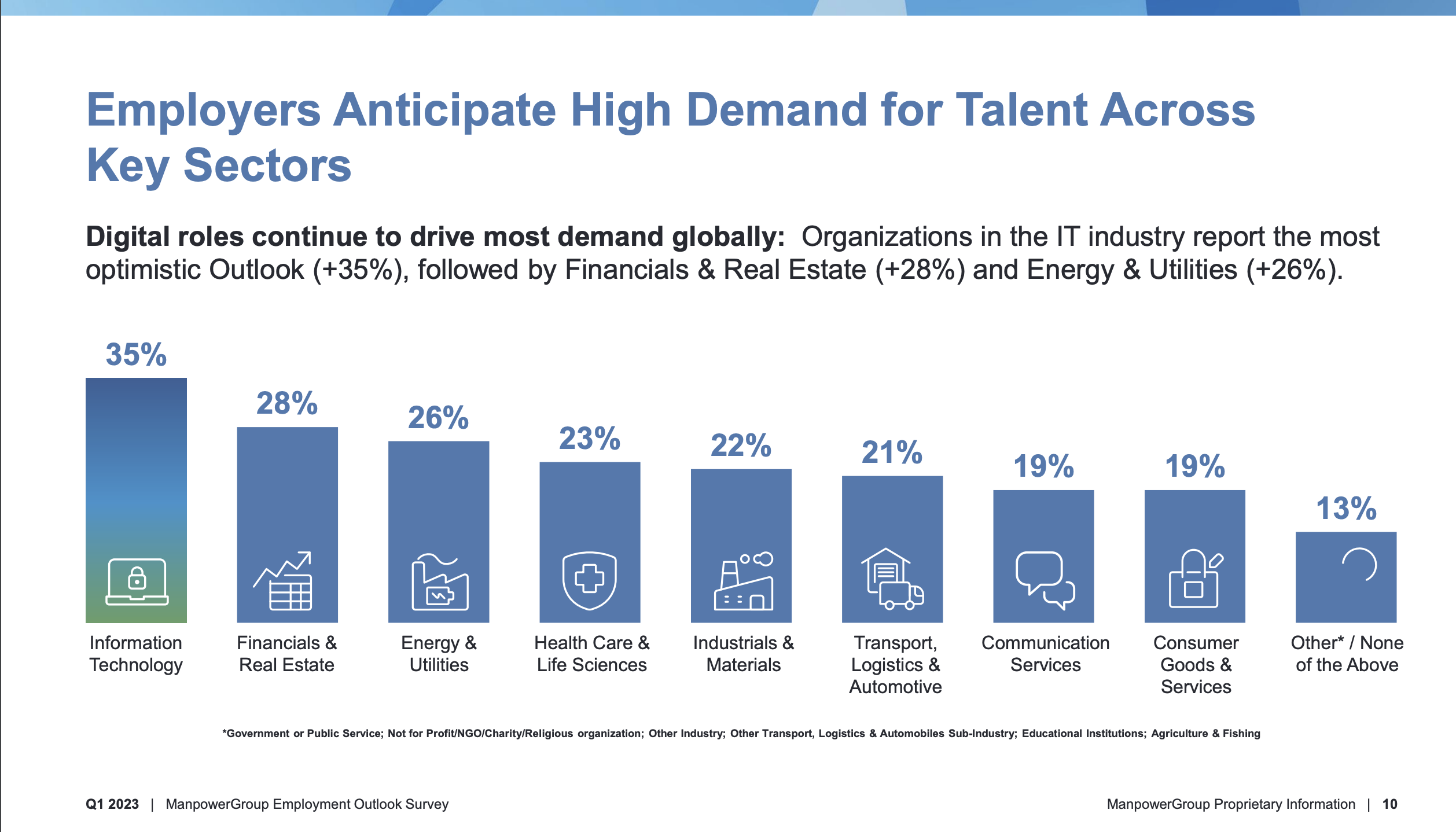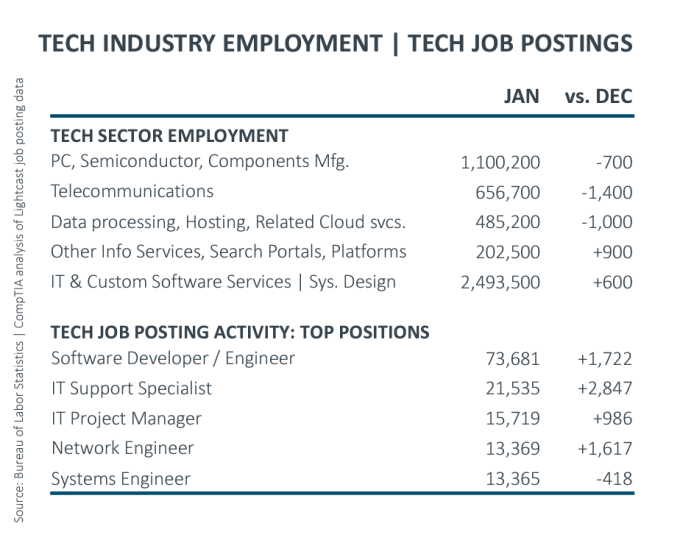When you lose 100,000 jobs in one month, as happened in tech in January, it’s easy to think that the bottom is falling out of the tech jobs market. The torrent of big company layoffs has been swift and brutal, with Microsoft, Alphabet, Amazon and Salesforce, among others, laying off thousands each.
But as with everything else in this economic downturn, nothing is as it seems, or certainly not as clear cut as it was in 2008 or after the dot-com bubble burst in 2000 when the economy crashed hard, and it was a long rough ride back to stability.
The justification for these layoffs is cutting operations costs and increasing profits, perhaps reducing payroll that swelled during the height of the pandemic. It’s a savage business, but a careful look at the jobs data suggests that maybe it isn’t quite as bad as it appears at first blush.
The conventional wisdom suggests that these job cuts have to eventually catch up with us, but so far, tech workers — especially those with specialized skills like engineering, data science, AI and cybersecurity — continue to be in demand as supply lags behind the number of open jobs.
The people let go by Big Tech just may not be going to other tech companies.
Companies and governments at every level have been clamoring for people with tech skills. And likewise, laid-off tech workers who are perhaps craving more stability may welcome the security that some of these other industries offer. Changing industries also gives people a chance to use their skills in a different way.
We dug into the tech jobs data and spoke to some jobs experts and people doing hiring, allowing us to paint a more positive picture than recent headlines would suggest. Maybe these scorned employees will have the last laugh after all.
Something’s happening here
And as Buffalo Springfield once sang, “What it is ain’t exactly clear.” The data is confusing. We’re seeing companies lay off tens of thousands of people, and yet the jobs picture remains surprisingly robust.
Consider that across all sectors, there was a net gain of 517,000 new jobs in January and the unemployment rate matched a 53-year low. That doesn’t feel like any recession I’ve ever experienced.
Atta Tarki, founder and chairman of executive search and staffing firm ECA Partners, and author of the book “Evidence-Based Recruiting,” says the evidence suggests that the jobs market remains tight across the board, especially for tech jobs.
“It seems based on all these headlines exploding, and all the employers I’m talking to are asking, ‘Well, isn’t it going to be Armageddon right now?’ And I’ve been telling them this for a long time, it seems worse than it is. And even in the tech sector [with all these layoffs], it seems worse than it is.”
Manpower, in its latest monthly employment survey of employers, found that in the IT sector, 76% of employers surveyed said that it was still difficult to find people with the necessary skills to fill open positions. What’s more, half of all surveyed expected to be adding to their staff in the first quarter, while just 16% reported decreases in staffing.
Nicholas Marshall, sales enablement director at ManpowerGroup, agrees with Tarki that things are much better than they appear.
“The perception is that, hey, there’s tons of layoffs going on. But what we see is that over the past two years, those tech companies had over-hired, and it’s more of a correction and a flattening out, but that there’s still a strong demand and employment outlook,” he said. He said that in fact, we aren’t seeing an overall decline, and there is still “a really strong employment outlook for the tech industry as a whole.”
Overall the company reported a net employment outlook of 35%. They derive that number by taking the percentage of employers anticipating an increase in hiring activity and subtracting from this the percentage of employers expecting a decrease in hiring activity.
It’s a strong outlook, but not as good as it was last year at this time, down 16% over the prior year, and down nine points over the prior quarter. So it’s tightening, but not as much as you would think given the massive number of people we’ve seen laid off over the last year.
Still it was a more optimistic employment outlook than any other industry, as the slide below shows:

No thanks, Big Tech
So if the Big Tech companies are laying off, and the overall jobs numbers aren’t declining appreciably, where are all these folks landing? What we begin to see is that some of the people being laid off by tech companies are landing in non-tech companies — if the job posting data is any indication.
Tim Herbert, chief research officer at CompTIA, a company that issues certifications for the IT industry, follows the tech jobs data and issues monthly reports. This includes looking at the Bureau of Labor Statistics’ jobs numbers and tech job postings across industries.
He says the January report was a mixed bag for tech jobs with the net new jobs dropping into negative territory after 25 consecutive months of positive growth to -700 jobs, a number that will likely get worse in February with the jobs lost in January. But there was good news, too, to offset that: The number of job postings across tech job types actually increased as the chart below illustrates.

In fact, the data shows a big increase in postings for tech jobs in industries like government, manufacturing, insurance and financial services. According to CompTIA the top companies posting for tech jobs this past month included financial services like Citi with the IRS coming in third for the most openings.
Herbert said these companies feel like they can compete better for tech workers now than they could last year. “The implication is that there are a lot of these sectors that probably view this as an opportunity to avoid some of the frenzy that we saw this time last year. I mean the market was just on fire in terms of the competition for tech talent. There was lots of concern over increasing salaries.”
“So you could definitely see some of these companies — and frankly, some of these companies they’re not going to have the same brand recognition as working in Silicon Valley — probably being in a better position to hire now,” Herbert said.
What are hiring managers saying?
We spoke to several CIOs and hiring managers, and the message was clear. They may be more careful with spending, and that includes hiring, but they are still for the most part hiring, and that corresponds with the data. What’s more, the market may be loosening a bit for less technical workers, but it remains tight for people with more specialized skills.
Monica Caldas, CIO at Liberty Mutual, says she’s definitely hiring with hundreds of openings across engineering, data science and cybersecurity, and it’s not appreciably easier to do so than it was six to nine months ago, even with the tech layoffs.
“If you look at CIO budgets and worldwide IT spending, you start to look at what people are spending money on, you see common threads on operational excellence, digitization, cyber insights and analytics data work. And those are all the areas that we’re competing for talent more and more. And so I don’t think it is significantly easier or materially easier,” Caldas told TechCrunch.
The way Sharon Mandell, CIO at Juniper Networks, is hiring is changing a bit to accommodate changes in spending. “I’m hiring, and I’m hiring FTEs. I’m also hiring contract-to-hire, and I’m slowing my pace down so that it makes the dollar go longer,” she said.
Hiring is slowing a bit, says Alexa Shanahan, director of recruiting at Starburst Data, a Boston startup that’s raised over $400 million. But she’s not putting on the brakes fully. “Our headcount has reached over 600 employees globally. We saw well over 50% headcount growth last year, and a considerable amount of that actually occurred in H2,” she said. “Over the next few months, we are primarily focused on growing and investing in R&D to support the growth of our Enterprise and Galaxy products. As a result, we have fewer than 10 open positions at the moment, the majority of which are in our product and engineering teams.”
Molly Austin, senior director of people at D2iQ, a San Francisco startup that helps simplify Kubernetes deployment, is still hiring and she says that it’s still difficult to find people with the right skill set for their company.
“For D2iQ, the hiring landscape really has not eased that much in the last year. The pool of talent with Kubernetes experience is relatively small and it’s still challenging to find incredible people, especially across sales and business development for us right now. Amazing people and talent will always be in high demand and we’re noticing that’s still the case even with recent layoffs,” she said.
But Austin says that hiring has eased a bit in less technical roles. “I’ve noticed that HR and recruiting roles have been the most prevalent among the layoff lists, and we just filled an open people operations manager role with an incredible candidate before the holidays without a problem.”
The obvious question is will there be a lag as the sheer number of people being laid off finally catches up with the number of open jobs. Tarki doesn’t think so.
“I’ve been constantly hearing this message that when next month’s numbers come in, it’s going to be Armageddon since March of last year,” he said. “Well guess what? April’s data came, and it didn’t happen. Same for May, June, July. And yeah, we saw a little bit of an uptick in October. We might see a little uptick in January [because of the layoffs at the Big Tech companies], but the sky is not falling. The labor market remains stronger than it seems.”







